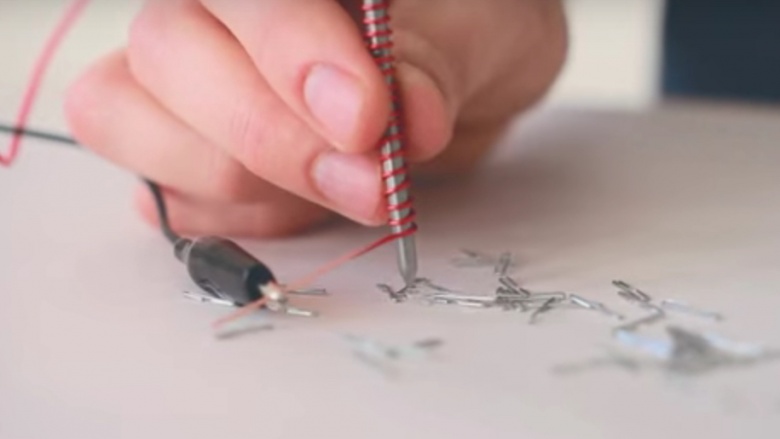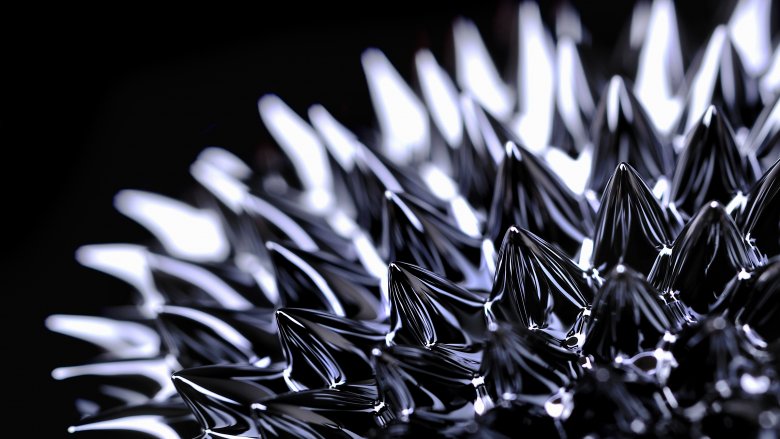Bizarre Science Experiments You Can Do At Home
Magnets are pretty cool, but an electromagnet is better. To make one, you will need a large iron nail, a length of coated copper wire, a D cell or 4 AA batteries in a battery pack, and some alligator clips to attach the wire to the battery. Wind the coated copper wire around the iron nail as many times as you can fit, then trim the wire, leaving a couple of inches loose at each end. Scrape the coating off the loose ends of the wire to expose the copper, and use the alligator clips to attach the wire to the battery. You should now have a working electromagnet.
Create colorful flowers
Creating custom-colored flowers is almost as simple as just buying flowers for your home. Simply buy some white flowers and leave them out of water for a while to get a bit thirsty. Put some water in a jar and mix in any food coloring of your choice, the more the better. Cut the stem of the flower at an angle and place it in the colored water. Over the next 6-24 hours, the flower will draw up the water and the coloring, gently tinting its petals.
Sometimes it seems like children get all the fun. They get to play and try out new things all the time, while the rest of us have to work and watch them play. But it doesn't have to be that way. Here are a few funky and bizarre science projects that anyone can do, along with some chemistry-based tricks that kids probably shouldn't do. Don't forget your safety goggles!
Create your own hybrid rocket engine
While you won't be breaking orbit with this rocket, it is an excellent and simple example of how a hybrid rocket engine works. All it requires is yeast, hydrogen peroxide, a small canning jar with an 1/8th of an inch hole cut in the lid, and some straight dry pasta tubes. The hydrogen peroxide will react with the yeast and produce oxygen which, when directed through the pasta and ignited, will create a small jet of flame. To create the rocket engine, fill the jar 3/4ths full with the hydrogen peroxide, and add 1/4th of a tsp of yeast. Put the lid on the canning jar but don't screw it down—this avoids the risk of dangerous pressure build up should the hole in the lid get blocked. Place a piece of pasta over the hole so that the oxygen being released by the jar is directed up through the tube. Put on safety glasses, light the end of the pasta, and enjoy the show.
Ferrofluid
A ferrofluid is a fluid containing microscale ferromagnetic particles that reacts to a magnetic field by forming shapes. It can be made by mixing printer toner (containing iron oxide) with vegetable oil in a glass—the mixture should be quite fluid. While tipping the glass to get a thin layer, hold a strong, rare-earth magnet (costs a few bucks online or from a hardware store) to the glass under the liquid. You should see the fluid react to the magnet by rising into a clump and forming wild, spiky shapes that spin and change as you move the magnet.
The egg and the bottle
Astound your friends and/or children with this amazing science trick. You will need a hard boiled egg without its shell, a glass bottle with a neck narrower than the egg, and two small candles. Light the candles and gently drop them into the bottle without letting them go out. With the candles burning in the bottle, simply place the egg on the neck and watch. The candles will heat the air in the bottle, causing it to expand. As the egg blocks the bottle's airway, the candles exhaust the oxygen inside and go out, whereupon the air cools and contracts, creating a small vacuum which sucks the egg into the bottle.
Moving liquid art
This colorful experiment plays with surface tension and the reaction between milk fat and soap. First, pour milk onto a plate until a thin layer covers the bottom completely. Whole milk works better than skim for this experiment as it contains more fat. Once the milk has settled, drip food coloring into the milk however you want. Coat the end of a Q-tip in a thin layer of dish soap and carefully touch the Q-tip onto the surface of the milk. The milk, and the coloring in it, will suddenly start to move away from the soap, creating beautiful patterns. This happens because the soap spreads out and bonds with the fat in the milk, disrupting the surface tension, which allows the milk to move.
The non-popping balloon
This experiment demonstrates the ability of water to absorb and transfer heat. You will need two balloons, some water, and a candle. Blow up the first balloon and tie its neck. Brace yourself for a shock and gently touch the balloon to the flame. Obviously, it will pop. With the second balloon, first pour a little water into it—make sure to stretch it a bit to make it more elastic. With water in the balloon, blow it up like the first one and again tie the neck. Hold the balloon to the candle flame and... nothing happens. As the flame touches the surface of the balloon, the water inside is able to draw the heat away fast enough to prevent the balloon's explosion.
Make glass invisible
Master the power of invisibility with this cool experiment. You will need a small Pyrex test tube, or a small Pyrex dish; a larger, clear container that the Pyrex will fit in; and vegetable oil. Fill the larger container with enough oil to submerge the test tube and slowly submerge the tube in the oil, allowing the fluid to run inside. As the test tube is completely submerged, it will appear to vanish. The Pyrex test tube and the oil have the same refractive index, which affects how light behaves as it passes through them. Pyrex and air have different refractive indexes, which means that as light passes from the air into the Pyrex and back into the air, it bends and reflects, allowing us to see the glass. When the Pyrex is submerged in the oil, there is no variation in the refractive index, so light passes straight through, rendering the Pyrex effectively invisible.

